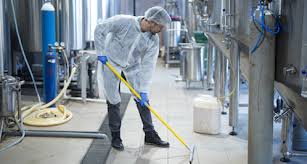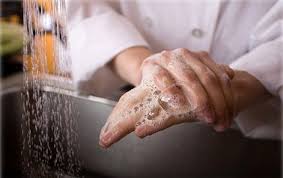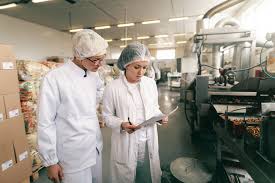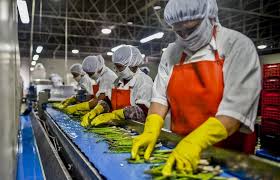Proper sanitation involves maintaining cleanliness and hygiene in food processing environments. It encompasses various practices aimed at preventing contamination and ensuring food safety. Effective sanitation helps reduce the risk of foodborne pathogens and other contaminants that can compromise food quality and safety.
Importance of Equipment and Facility Sanitation
Equipment and facility sanitation are vital for several reasons:
1. Prevents Contamination: Regular cleaning and sanitizing of equipment and facilities help prevent cross-contamination from harmful bacteria, allergens, and other contaminants.
2. Ensures Food Safety: Maintaining a clean environment reduces the risk of foodborne illnesses, protecting consumers and ensuring compliance with food safety regulations.
3. Enhances Product Quality: Clean equipment and facilities contribute to the overall quality of food products, ensuring that they are safe, fresh, and free from unwanted flavors or odors.
4. Complies with Regulations: Sanitation practices are often mandated by health and safety regulations. Adhering to these standards is essential for food processors to operate legally.
5. Builds Consumer Trust: A commitment to sanitation helps build consumer confidence in the safety and quality of food products, enhancing brand reputation.
Key Sanitation Practices for Equipment

To ensure that equipment remains clean and safe for food processing, implement the following key practices:
1. Regular Cleaning Schedule: Establish a regular cleaning schedule for all equipment used in food processing. Frequent cleaning minimizes buildup of dirt and bacteria.
2. Disassembly for Cleaning: Whenever possible, disassemble equipment for thorough cleaning. This allows for access to hard-to-reach areas where contaminants may accumulate.
3. Use Appropriate Cleaning Agents: Select cleaning agents that are safe and effective for the type of equipment being cleaned. Use non-toxic, food-safe cleaning products whenever possible.
4. Rinse Thoroughly: After cleaning, rinse equipment thoroughly to remove any cleaning agents, residues, or contaminants. Ensure that no cleaning agents remain on surfaces that contact food.
5. Inspect After Cleaning: Conduct visual inspections of equipment after cleaning to ensure that all surfaces are free from dirt and residues. Address any issues before equipment is used again.
Steps for Effective Facility Sanitation
To maintain a clean facility, follow these steps for effective sanitation:
1. Develop a Cleaning Plan: Create a comprehensive cleaning plan that outlines specific cleaning tasks, frequencies, and responsible personnel for each area of the facility.
2. Remove Debris and Waste: Before cleaning, remove any debris, waste, or materials from the area. This step makes it easier to clean surfaces effectively.
3. Clean Surfaces: Use appropriate cleaning agents to clean all surfaces, including floors, walls, countertops, and equipment. Focus on high-touch areas that are more prone to contamination.
4. Sanitize Surfaces: After cleaning, use food-safe sanitizing agents to disinfect surfaces. Follow the manufacturer’s instructions for proper dilution and contact time.
5. Dry Thoroughly: Allow surfaces to air dry or use clean cloths to dry them thoroughly. Moist surfaces can promote bacterial growth.
6. Train Staff: Train all staff members on proper sanitation procedures to ensure consistency and adherence to safety standards.
Read Also Principles and Techniques in Livestock Breeding (Methods of Genetic Improvement)
Recommended Sanitizing Agents and Tools

Using the right sanitizing agents and tools is essential for effective sanitation. Here are some recommended options:
1. Sanitizing Agents:
i. Chlorine Bleach: A widely used sanitizer that is effective against a broad range of bacteria. Dilute according to manufacturer instructions for safe use.
ii. Quaternary Ammonium Compounds (Quats): These are effective against bacteria and viruses and are often used in food processing settings.
iii. Hydrogen Peroxide: A non-toxic sanitizer that is effective against bacteria and fungi. It breaks down into water and oxygen, making it safe for food environments.
iv. Vinegar: An eco-friendly option for cleaning and sanitizing surfaces, although it may not be as effective against certain pathogens as commercial sanitizers.
2. Cleaning Tools:
i. Scrub Brushes: Use brushes to clean equipment and surfaces effectively, especially in hard-to-reach areas.
ii. Microfiber Cloths: These are effective for cleaning and sanitizing surfaces without leaving lint or residues.
iii. Mops and Brooms: Maintain facility cleanliness with mops for wet cleaning and brooms for dry sweeping.
iv. Pressure Washers: For large equipment and outdoor areas, pressure washers can effectively remove dirt and contaminants.
Maintaining a Sanitation Schedule
A well-defined sanitation schedule is vital for ensuring that all areas of a food processing facility are regularly cleaned and sanitized. Here’s how to establish and maintain an effective sanitation schedule:
1. Create a Cleaning Checklist: Develop a detailed checklist that outlines all cleaning tasks for each area of the facility. Include specific tasks, such as cleaning equipment, floors, walls, and utensils.
2. Determine Frequency: Identify how often each task should be completed (e.g., daily, weekly, or monthly) based on the level of use and risk of contamination. High-risk areas, such as food preparation zones, may require daily cleaning.
3. Assign Responsibilities: Designate specific staff members responsible for each cleaning task. Ensure that each staff member understands their responsibilities and the importance of following the schedule.
4. Record Keeping: Maintain a log of cleaning activities, noting when tasks were completed and by whom. This documentation helps track compliance and provides accountability.
5. Regularly Review and Update: Periodically review the sanitation schedule to ensure it remains effective. Update it as needed based on changes in operations or regulations.
Read Also Digestive Anatomy of Ruminants
Training Staff on Sanitation Procedures

Training is crucial to ensure that all staff members understand and follow proper sanitation practices. Here’s how to implement effective training:
1. Develop a Training Program: Create a comprehensive training program that covers sanitation procedures, the importance of hygiene, and the proper use of cleaning agents and tools.
2. Conduct Regular Training Sessions: Schedule regular training sessions to educate new hires and refresh the knowledge of existing staff. Use interactive methods such as demonstrations and role-playing to enhance learning.
3. Provide Clear Instructions: Use clear, simple language and visual aids to explain sanitation procedures. Ensure that all staff members understand the steps involved in cleaning and sanitizing equipment and facilities.
4. Emphasize Personal Hygiene: Train staff on the importance of personal hygiene, including proper handwashing techniques, wearing clean uniforms, and using gloves when necessary.
5. Evaluate Understanding: Assess staff understanding of sanitation procedures through quizzes, observations, or practical assessments. Address any gaps in knowledge promptly.
Common Sanitation Challenges and Solutions
Sanitation can present various challenges in food processing environments. Here are some common challenges and effective solutions:
1. Inconsistent Cleaning Practices: Implement a detailed sanitation schedule and checklist to ensure consistency. Regularly train and remind staff of their responsibilities.
2. Difficulty in Accessing Hard-to-Reach Areas: Use specialized cleaning tools, such as long-handled brushes or pressure washers, to reach difficult areas. Schedule deep cleaning to thoroughly clean these spaces.
3. Resistance to Change Among Staff: Solution:** Foster a culture of safety and quality by emphasizing the importance of sanitation in protecting public health. Encourage open communication and address concerns.
4. Limited Time for Cleaning: Solution:** Optimize production schedules to allocate adequate time for cleaning. Ensure that cleaning tasks are prioritized without compromising food safety.
5. Improper Use of Cleaning Agents: Train staff on the correct use of cleaning agents, including proper dilution and application methods. Clearly label all cleaning supplies to prevent misuse.
Monitoring and Evaluating Sanitation Effectiveness
Regular monitoring and evaluation of sanitation practices are essential to ensure their effectiveness. Here’s how to implement a monitoring system:
1. Establish Key Performance Indicators (KPIs): Define specific KPIs to assess sanitation effectiveness, such as compliance rates with the sanitation schedule, frequency of contamination incidents, and employee adherence to hygiene practices.
2. Conduct Regular Inspections: Schedule routine inspections of equipment and facilities to assess cleanliness and compliance with sanitation protocols. Document findings and address any issues immediately.
3. Solicit Feedback from Staff: Encourage staff to provide feedback on sanitation practices and challenges they encounter. This input can help identify areas for improvement.
4. Review Cleaning Logs: Regularly review cleaning logs to ensure that tasks are being completed as scheduled. Investigate any discrepancies or missed tasks.
5. Continuous Improvement: Use the data collected from monitoring activities to identify trends and areas for improvement. Make necessary adjustments to the sanitation program based on findings.
Proper sanitation in food processing is essential for ensuring food safety, quality, and compliance with regulations.
By implementing effective sanitation practices for equipment and facilities, food processors can significantly reduce the risk of contamination and foodborne illnesses.
Training staff and using the right sanitizing agents and tools further enhance the effectiveness of sanitation efforts, leading to a safe and hygienic food processing environment.
Maintaining proper sanitation in food processing is essential for ensuring food safety and quality. By establishing a sanitation schedule, training staff, addressing common challenges, and monitoring effectiveness, food processors can create a safe environment that minimizes the risk of contamination.
A commitment to sanitation not only protects consumers but also enhances the reputation of food processing operations.
Do you have any questions, suggestions, or contributions? If so, please feel free to use the comment box below to share your thoughts. We also encourage you to kindly share this information with others who might benefit from it. Since we can’t reach everyone at once, we truly appreciate your help in spreading the word. Thank you so much for your support and for sharing!
Read Also How to Make Your Own Organic Pesticides

